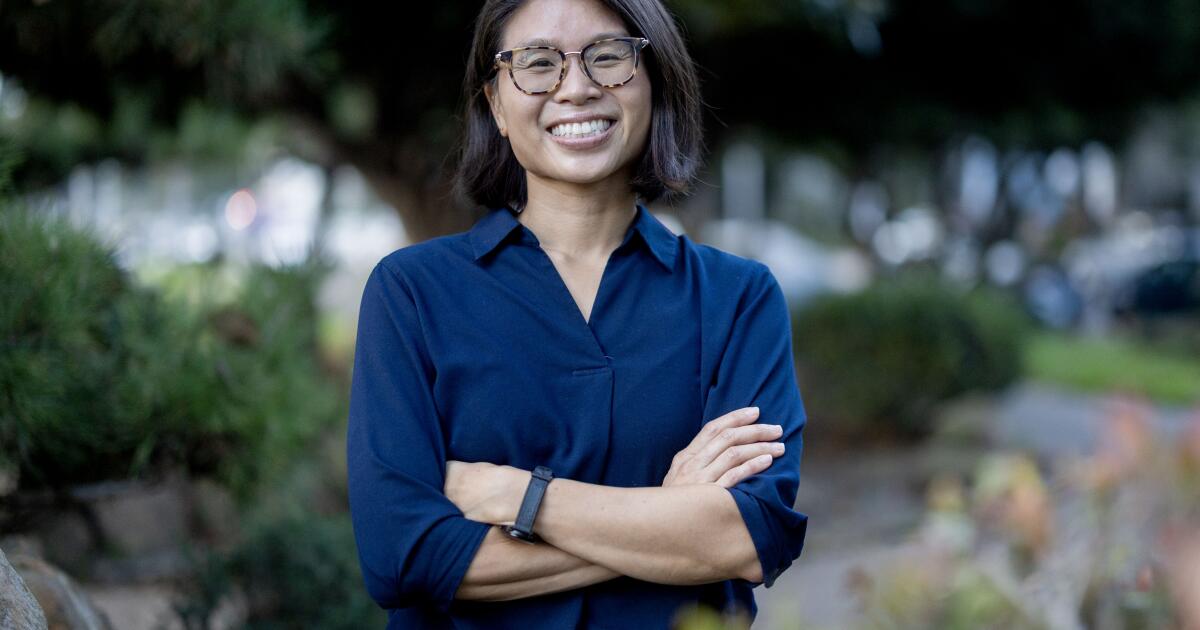‘Suffs’ review: How women won the vote. The musical.
“Suffs,” Shaina Taub’s musical about how women finally secured the right to vote in America, won Tony Awards for its book and score. It lost the best musical race to “The Outsiders,” but the respect it earned when it opened last spring on Broadway made it an unequivocal winner.
The show is having its Los Angeles premiere at the Hollywood Pantages Theatre in a touring production that is smooth and smart. Taub’s work deserves nothing less than an A. The cast is excellent, the staging is graceful and the political message could not be more timely.
The show might not have the crackling vitality of “Hamilton” or the bluesy poignancy of “The Scottsboro Boys.” It’s a good deal more earnest than either of these history-laden musicals. There’s an educational imperative at the heart of “Suffs,” which deals with a subject that has been marginalized in schools and in the collective consciousness.
The 19th Amendment, which gave women the right to vote, was ratified in 1920, a little more than a century ago. The history isn’t so distant yet I’m sure I wasn’t the only one at Wednesday’s opening who was learning about the forceful tactics that helped Alice Paul and her fellow suffragists push their movement over the finish line.
“Suffs,” a musical for the public square, is as informative as it is uplifting. It is above all a moving testament to the power of sisterhood. The struggle for equality continues to face crushing setbacks today, but Taub wants us to remember what can happen when people stand united for a just cause.
Alice (a winning Maya Keleher) doesn’t seem like a rabble-rouser. A bright, well-educated woman with a polite demeanor, she looks like a future teacher of the year more than a radical organizer. But she has an activist’s most essential quality: She won’t take no for an answer. (Keleher lends alluring warmth to the role Taub made her Broadway debut in.)

Marya Grandy and the company of the national tour of “Suffs.”
(Joan Marcus)
She’s rebuffed by Carrie Chapman Catt (Marya Grandy), the president of the National American Woman Suffrage Assn., whose motto (“Let your all-American mother vote”) is the basis for the show’s opening number, “Let Mother Vote” — a distillation of the old-guard approach that has yet to yield women the vote.
Alice wants to organize a march in Washington, D.C., to force the president’s reluctant hand, but Carrie prefers a more genteel strategy. “Miss Paul, if my late great mentor Susan B. Anthony taught me anything, it’s that men are only willing to consider our cause if we present it in a lady-like fashion.
“State by state, slow and steady, until the country’s ready” is, after all, NAWSA’s fundamental creed. But Alice points out that if they continue at this glacial pace they’ll be dead before they can ever cast a vote.
Swinging into action, Alice teams up with her friend Lucy Burns (Gwynne Wood), who worries that they haven’t the experience to take on such a momentous mission. “We’ve never planned a national action before,” she objects at the start of their duet “Find a Way.” But undaunted Alice has the bold idea of recruiting Inez Milholland (played at the opening night performance by Amanda K. Lopez), and a way forward miraculously materializes.
Inez has just the right glamorous public image that Alice thinks will give their march the publicity boost it needs. Studying for the bar exam, Inez is initially reluctant but agrees if she can lead the march on horseback.
This image of Inez on a steed becomes central both to the movement and to director Leigh Silverman’s production, which finds simple yet striking ways of bringing revolutionary change to life. A chorus line of activists wearing suffragist white (kudos to the luminous tact of costume designer Paul Tazewell) eloquently communicates what solidarity can pull off.

Brandi Porter, left, and Jenny Ashman as President Woodrow Wilson in “Suffs.”
(Joan Marcus)
An all-female and nonbinary cast dramatizes this inspiring American story. Taub takes some fictional license with the characters but largely sticks to the record.
Notable allies in Alice’s organization include Ruza Wenclawska (Joyce Meimei Zheng) a Polish-born trade union organizer with a no-nonsense grassroots style, and Doris Stevens (Livvy Marcus), a shy yet undeterred student from Nebraska who becomes the group’s secret weapon secretary.
Ida B. Wells (Danyel Fulton), an early leader in the civil rights movement, takes part in the march but resists being used as a prop in what she calls NAWSA’s “white women convention.” Mary Church Terrell (Trisha Jeffrey), a fellow Black activist, by contrast believes that it’s only through participation that representation can move forward.
President Woodrow Wilson (Jenny Ashman), who makes promises to the suffragists he is hesitant to keep, is a crucial target of Alice’s pressure campaign. Her group’s access to him is aided by Dudley Malone (Brandi Porter), Wilson’s right-hand man, who becomes smitten with Doris.
The score marches ahead in a manner that makes progress seem, if not inevitable, relentless in its pursuit of justice. The songs combine the patriotic exuberance of John Philip Sousa and the American breadth of Broadway composer Stephen Flaherty (“Ragtime”). The note of pop accessibility in Taub’s music and the satiric humor of her lyrics add to the buoyancy. You won’t leave humming a tune, but the overall effect (while ephemeral) is pleasing in the theater.
With the history already determined, the book can’t help resembling at times a civics exhibition. Dramatic tension is hard to come by. Alice and her cohorts suffer grave disappointments and indignities (including a harrowing stint in prison), but the eventual outcome of their struggles is known.
“Suffs” sometimes feels like a history lesson neatly compartmentalized into Important Episodes. There’s a whiff of PBS to the way the musical unfolds. This is cultural programming that’s good for you.
But the teamwork of the performers honors the messy yet undeniably effective cooperation of Alice and her freedom fighters — women who changed the world by not staying silent in their prescribed place.
‘Suffs’
Where: Hollywood Pantages Theatre, 6233 Hollywood Blvd., L.A.
When: 7:30 p.m. Tuesday-Thursdays, 8 p.m. Fridays, 2 and 8 p.m. Saturdays, 1 and 6:30 p.m. Sundays. (Check for exceptions.) Ends Dec. 7.
Tickets: Start at $57 (subject to change)
Contact: BroadwayInHollywood.com or Ticketmaster.com
Running time: 2 hours, 30 minutes (one intermission)



